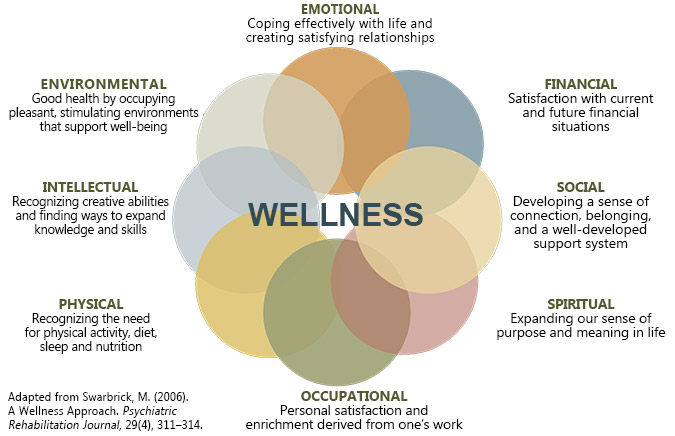Mapping Mental Health: Dr. Swarbrick & The Eight Wellness Dimensions
Wellness (n.)
A conscious, deliberate process that requires a person to become aware of and make choices for a more satisfying lifestyle.
The Wellness model, one of Dr. Swarbrick’s more well-known creations, has been spreading swiftly through medical communities and forums since its inception since the early 1990’s. Swarbrick’s focus on the concept of wellness, inspired by Dr. Jerry Johnson’s “Wellness and Occupational Therapy” (1986), stemmed from a greater desire to address disparities facing people with or at risk of developing mental or substance use disorders.
Interested to learn more about the creation of the model, I spoke with Dr. Swarbrick about the ideas and concepts behind its invention.
“This model has evolved over many years based on the lived experiences of people facing traumatic life experiences, substance use, and mental health challenges”, she said. “Initially, the model included only 5 dimensions, but over time evolved to 8 based on the many needs and issues facing people on the field and in the street.”
Swarbrick’s ‘8 Dimensions’ model has been used to craft an effective framework for the pursuit of wellness. In no particular order, these dimensions are: Physical, Spiritual, Social, Intellectual, Emotional/Mental, Occupational, Environmental, Financial. The model (below) prominently features adjacent dimensions overlapping to convey the idea that all dimensions are connected and reliant on one another. When teaching the model, Dr. Swarbrick discusses how each dimension can impact one another both positive or negative. What has been the most successful aspect of this model is that it is strength focused building on people daily habits and routines, to build and strengthen new habits. People often identify key activities they do each day for example sleep, helps in multiple dimensions including physical, emotional and social. For short- and long-term recovery many people benefit on regularly checking in to consider what they do each day or week physically socially emotionally etc. We find that very often people can identify what they are doing and consider how they can continue to strengthen this daily habits and routines.
In time, Swarbrick would go on to organize a peer coaching program based on the concept of wellness and the ‘8 dimensions’ featured in the wellness model. Peer providers worked as wellness coaches to help support other peers to create realistic, achievable goals for self-betterment. Opening statements with ‘I will’ rather than ‘I will try’ allows people to commit to their self-betterment plans, and coaches work to offer the positive reinforcement needed to maintain and achieve long-term goals.

Interestingly, the long and successful 23-year lifetime of the 8 Dimensions of Wellness model has also given birth to several branching takes on Swarbrick’s wellness formula. I’ve yet to find a model that seeks to increase the number of dimensions to 9, but several models have taken steps in the opposite direction.
While searching for alternate Wellness models, I found two separate and unrelated models featuring 7 Degrees. The first populated various websites, with in-depth guides to the model varying stylistically from scholarly lessons to everyday, casual walkthroughs. Both guides appeared to provide the same general definition for ‘wellness’ as the one used by Dr. Swarbrick, and dropped the ‘Financial’ dimension. To compensate, they created a new segment: Career. Career acts as a fusion between ‘Financial’ and ‘Occupational’, but with a few major differences.
First, it asks the viewer for a more individualized assessment of wealth than Swarbrick’s model. Most employed persons thinking about their finances when oriented around the word ‘career’ will center around their own salaries: The amount of money they contribute to their personal or familial economy.
In contrast, Swarbrick’s model uses the term ‘financial’, which asks users for a more holistic assessment of each source of income and spending in their local economy. This can include gifts from families or others in one’s household, which may be more relevant for the individuals living with mental and substance use challenges.
Second, ‘career’ does not refer to a current ‘occupation’, but a path that leads into future opportunities. It asks viewers to look into the future and assess the likelihood that their current career path will be able to support them as they grow older.
These differences reflect a deliberate shift in design philosophy to better align this wellness model with its intended audience. Swarbrick’s model is meant to aid those struggling with mental disabilities, but this model has no such focus; both sources featured above directly encourage all readers to take tangible steps towards improving their own wellness. This suggests that the 7-degree model is intended for use by the general public as a framework for them to manage their own lives, rather than a framework upon which trained peers can construct life coaching sessions for the mentally ill.
When I looked at most of the other similar-but-different models, I was met with similar findings: Rather than simply re-hashing the same concepts with a marginally different graphic, each take on wellness was tweaked to suit the needs of a specific group of individuals. One model, for example, focused more on an individual’s view of how past events continue to affect their current well-being, and was featured on a website advertising a retirement home.
As my interview with Dr. Swarbrick came to a close, I presented to her my findings on differing models across the net. This came to no surprise to her, and she seemed grateful that her model has had such an impact.
“It has been amazing how well received this model has been”, she said. “[It has been] embraced by many people in the field, as well by as groups who are at risk of experiencing stress that impacts their own well-being and quality of life.”
